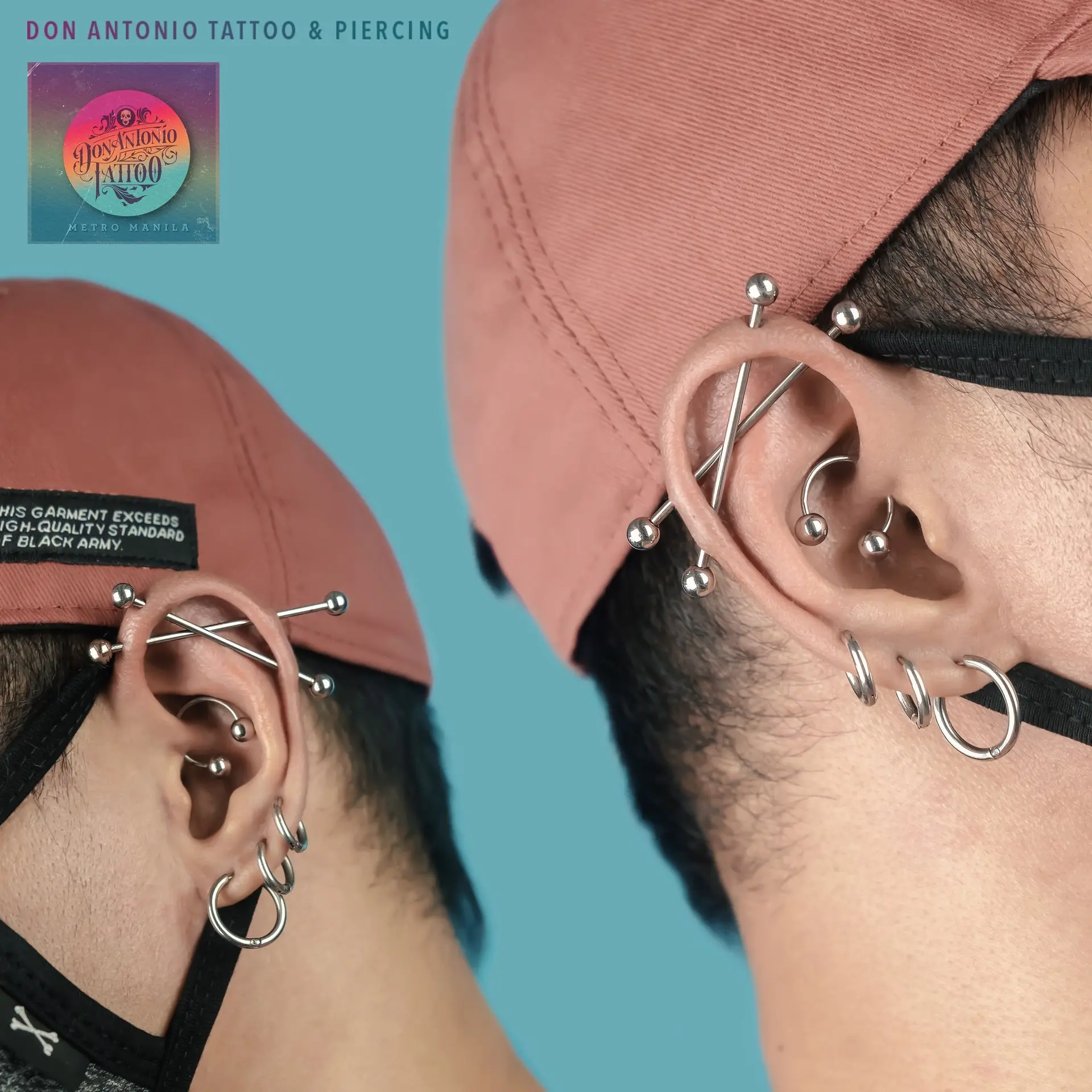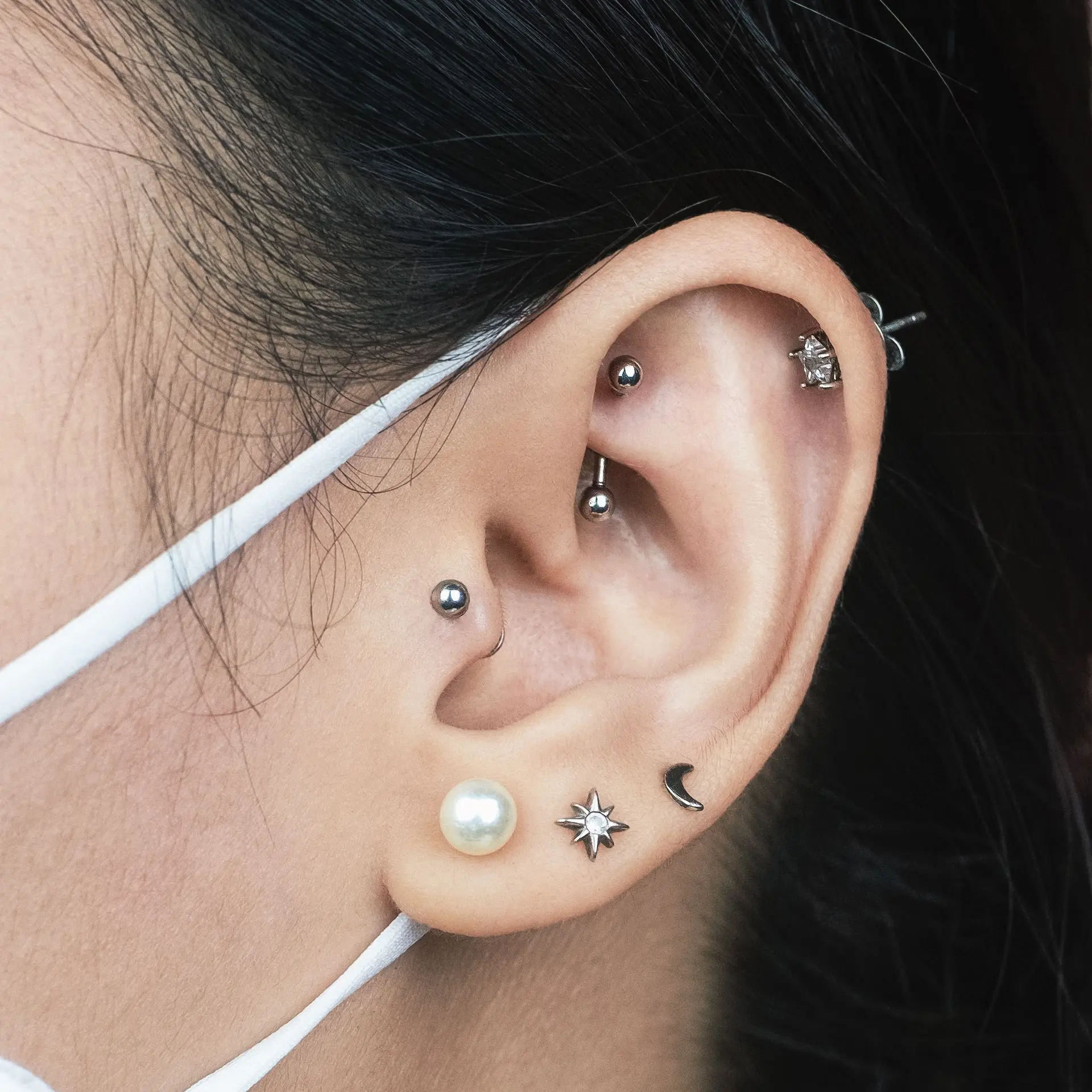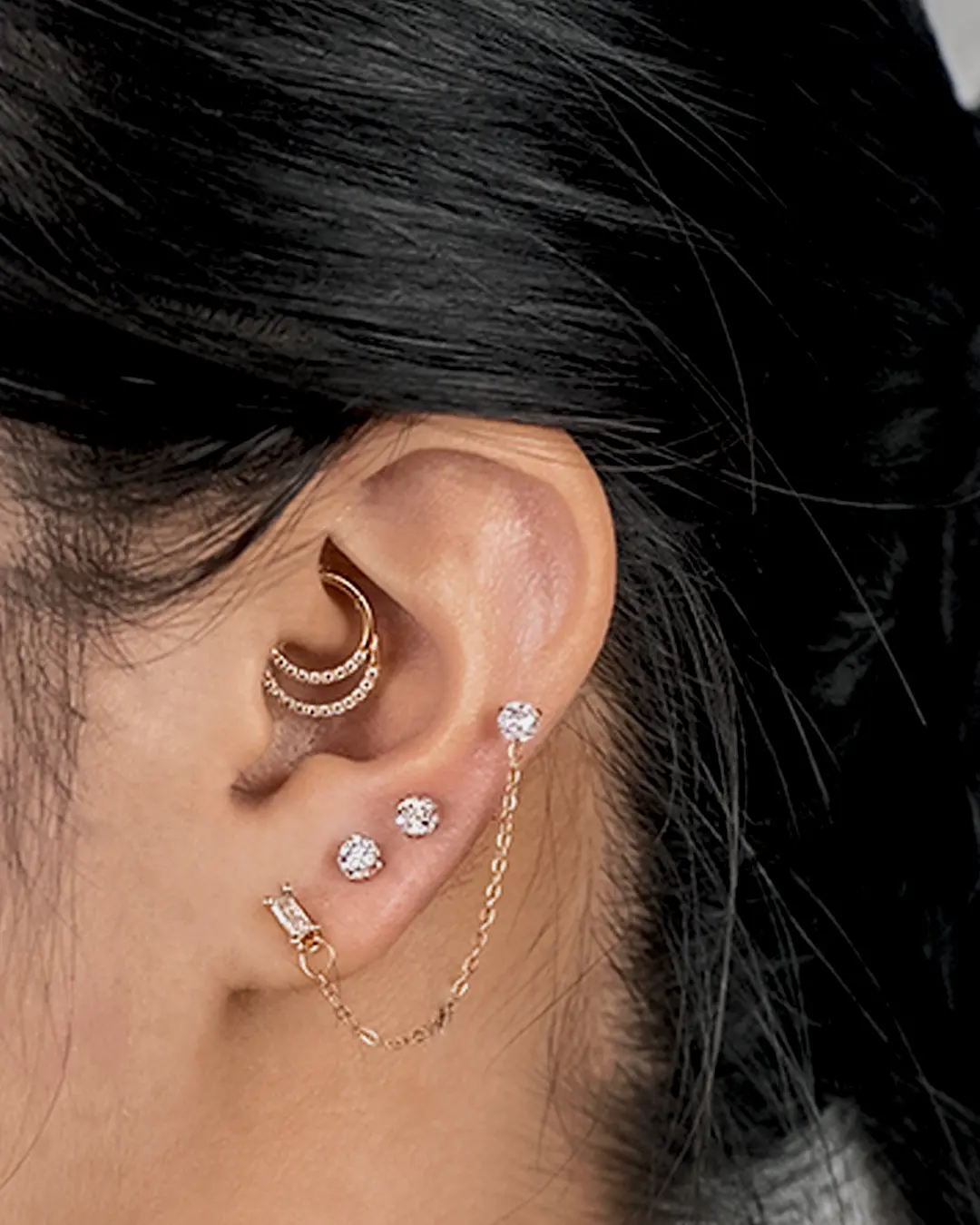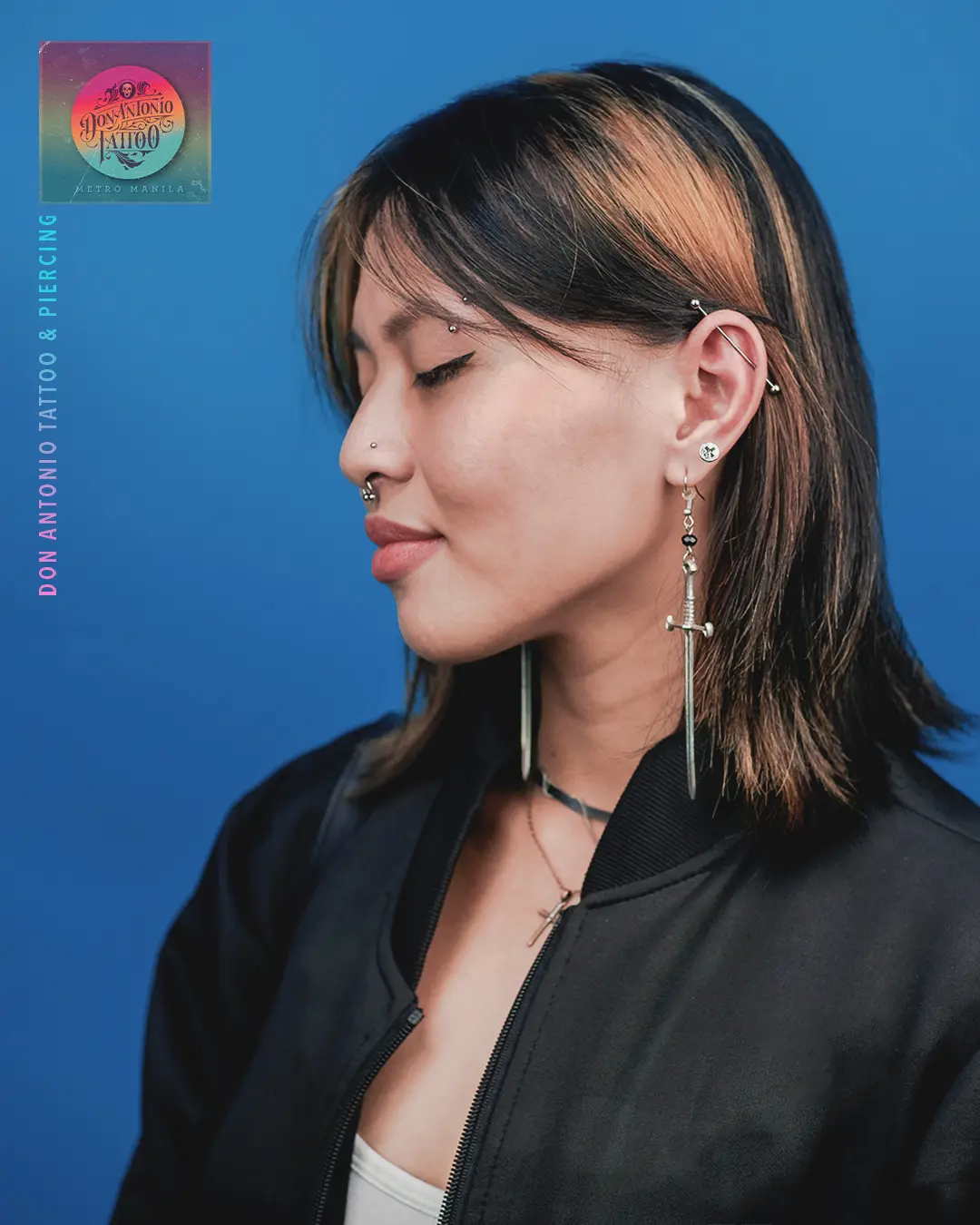Not all piercings are loud or rebellious. Some are quiet choices—like getting your lobes pierced after graduation, or marking a private milestone with something only you understand. Whether you're thinking of adding your first stud or mapping out a full ear curation, it helps to know what you're getting into. This is a guide to the most common ear piercings we see at our studio—how they feel, how they heal, and how they often mean more than they seem.
Why People Get Piercings — and How They Deal With the Pain
People get pierced for many reasons. To celebrate change. To feel something shift. To reclaim part of themselves after a breakup, a move, or a moment that’s hard to explain. Some just want something simple—something that’s theirs. A piece of jewelry placed with intention can become a way of saying: I’m still here. I’m still me.
The process itself feels intentional. A sharp breath. A quick pinch. And then, something new—quietly chosen, quietly worn. For many, the act of getting pierced becomes a pause—a moment to reconnect. It helps them feel more like themselves, or marks the decision to move forward.

For many, getting pierced becomes something transformative. Not because it changes who they are, but because it reminds them. It marks a choice, a turning point, or simply a moment when they decided to take up a little more space—for themselves. The pain fades, but the shift often lingers in how they carry themselves afterward.
A CLOSER LOOK:
A quick guide to what each piercing feels like—and why people choose them.

Lobe Piercing
Location: The soft, lower part of the ear
Healing time: 6–8 weeks
What it’s like: Almost everyone starts here. It’s low on pain, quick to heal, and easy to style. Lobe piercings are often part of family rituals or growing-up milestones—a memory held in a tiny shimmer.

Helix Piercing
Location: The outer upper edge of the ear cartilage
Healing time: 3–6 months
What it’s like: A subtle edge. Helix piercings look minimal but carry attitude. You might feel a pinch, but most clients describe it as pressure more than pain. It’s best to sleep on the opposite side while healing.

Tragus Piercing
Location: That small flap in front of your ear canal
Healing time: 3–6 months
What it’s like: Small, distinct, and stylish. Some say the tragus connects to grounding pressure points. Whether or not you believe that, it’s definitely a popular piece for people who like quiet statements.

Daith Piercing
Location: The fold of cartilage above your ear canal
Healing time: 6–9 months
What it’s like: One of the trickier piercings, but also one of the most personal. Some clients come in with migraine stories and hope. Others just love the tucked-in style. It’s harder to clean, so patience is key.

Conch Piercing
Location: The inner shell of the ear
Healing time: 6–12 months
What it’s like: Bold and central. Conch piercings create room for large hoops or flat discs. It’s not painful, just deep—and the healing takes time. We often see clients choose this as their second or third piercing.

Rook Piercing
Location: The inner ridge above the daith
Healing time: 6–12 months
What it’s like: A hidden gem—literally. Not everyone’s ear shape suits a rook, but if it does, the result is beautiful and unique. It’s pressure-heavy during the pierce, but many say the look is worth it.
Quick Reference Chart
This chart summarizes the healing time and general pain level for common ear piercings. Pain levels vary from person to person, but this guide offers a general sense of what to expect. Healing time depends on aftercare, body chemistry, and lifestyle habits like sleeping positions or wearing headphones.
| Piercing | Pain | Healing Time |
|---|---|---|
| Lobe | ⭐ | 6–8 weeks |
| Helix | ⭐⭐ | 3–6 months |
| Tragus | ⭐⭐ | 3–6 months |
| Daith | ⭐⭐ | 6–9 months |
| Conch | ⭐⭐ | 6–12 months |
| Rook | ⭐⭐⭐ | 6–12 months |
| Piercing | Area | Pain Level | Healing Time |
|---|---|---|---|
| Lobe | Soft | ⭐ | 6–8 weeks |
| Helix | Cartilage | ⭐⭐ | 3–6 months |
| Tragus | Cartilage | ⭐⭐ | 3–6 months |
| Daith | Cartilage | ⭐⭐ | 6–9 months |
| Conch | Cartilage | ⭐⭐ | 6–12 months |
| Rook | Cartilage | ⭐⭐⭐ | 6–12 months |
Healing Tips That Actually Help
- Clean gently with saline solution. Skip alcohol or harsh chemicals—they slow the healing.
- Hands off. It’s tempting, but touching introduces bacteria.
- Don’t twist the jewelry. That’s an old myth. Let the piercing settle.
- Sleep mindfully. Try a travel pillow or piercing pillow to reduce friction.
Give your body time to heal. The gentler you are, the better your piercing settles.

A Quick Recap

From lobe to rook, ear piercings carry more than just style. They reflect our stories, our turning points, and the small ways we mark change—quietly or boldly. Whether you're after something subtle or statement-making, knowing what to expect makes the experience more intentional.
There’s a reason people walk out of the studio standing taller. A piercing doesn’t just add to your look—it can remind you of who you are, or who you're becoming.
If you're thinking about getting pierced for the first time—or adding a new piece to your story—we’re here to guide you through it with care, clarity, and calm.
Note: Healing times and pain levels in this guide are based on our studio’s experience and client feedback. We also reference best practices from the Association of Professional Piercers. Actual healing may vary depending on individual care, body chemistry, and lifestyle.
Thinking of Getting Pierced?
Every piercing has a story—sometimes quiet, sometimes brave, always yours. At Don Antonio Tattoo, we pierce with care. Everything we use is sterilized, skin-safe, and done by professionals who want your piece to heal as beautifully as it looks.
👣
Walk-ins welcome
📲 Book a session online: www.donantoniotattoo.ink
📍 Don Antonio Tattoo – Quezon City
💳 GCash, Credit Card, and Cash Accepted
Home Portfolio Book Appointment